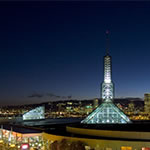In 2003, 13 years after construction of the original facility and shortly after an expansion that doubled its size, the Oregon Convention Center became the first convention center of its kind to receive LEED certification. Since then, it was designated LEED Silver under the Existing Buildings rating and, this year, earned LEED-EB Platinum certification. Director of operations Matt Uchtman, executive director Scott Cruickshank, and sustainability coordinator Erin Rowland—who have continually made the facility more energy efficient and environmentally responsive—share some of the center’s most innovative strategies.

The Oregon Convention Center added a rain garden in 2003.
Demonstration Rain Garden
Water conservation played a key role in the center’s original upgrade. Flush valves were switched out throughout the facility, providing greater efficiency, and in 2003, a rain garden was incorporated into the expansion. “It’s a unique feature of our facility that can be used as a demonstration piece to show how a stormwater-treatment facility can be incorporated into a building’s design,” Uchtman says. The garden captures rainwater from the roof and loading dock, which then flows through a series of channels and ponds lined with plants and rocks. They slow and cool the water as it flows and filter out pollutants before it infiltrates the soil, evaporates, or enters the sewer system.
Lower Wattage Lighting
Daylighting has been a priority at the convention center since as early as 1990, when the original building was built with an abundance of skylights and windows designed into it. But two major lighting projects completed in 2011 and 2013 resulted in the replacement of 1,000 400-watt metal halide lamps with 200-watt induction lights, cutting the expo halls’ energy use by half. In the meeting rooms, 250-watt quartz down lights were switched out for 14.6-watt LED lamps.
Efficiency Upgrades
“When the original building was constructed, it was assumed that expansion was likely,” Cruickshank says. “In 2003, the mechanical systems did not change much, and the features were blended.” Several challenges led to upgrading the controls on air-handling units to streamline the controllability and functionality of those units. Although the facility had been unable to shut down the boilers during the summer, requiring them to be kept at a constant temperature year-round, major upgrades to the gaskets and couplers have allowed them now to be turned off, which has resulted in energy savings of up to $50,000 per year.

Other progressive features have been around since the Oregon Convention Center was first constructed in 1990, such as its wide skylights.
Employee Engagement
In partnership with the Energy Trust of Oregon’s Strategic Energy Management program, convention center leadership has created an energy policy “to identify additional energy-saving opportunities,” Uchtman says, and is working towards employee behavioral changes by building an understanding of the staff on all levels of the facility to determine how they can contribute to energy efficiency. Of course, innovation and creativity are required in implementing an employee communications program, Rowland says. “We have employees in the building 24/7, and many do not have email,” she says. “So we have to be really creative and flexible in how we provide training.”
Creative Campaigns
An employee-led energy campaign was launched in January 2014 that offers training opportunities for staff of all kinds, from the kitchen to the marketing department. “Since we started the outreach campaign in January, we have seen approximately 10 percent in savings just by increasing awareness,” Uchtman says. The program includes educating employees about turning computer monitors off at night and shutting down hood systems in the kitchen when not in use. “I think that our success in this program has largely been that we have a group of employees that have taken this project on and have made it fun,” Cruickshank says. “They’ve created different activities and contests, scavenger hunt-type things, and have engaged employees in all work groups in a fun way. I think that has really been the key to this program.”
A Broader Impact
Uchtman, Cruickshank, and Rowland see their mission as extending a message of sustainability far beyond the convention center. “Really personalizing things has been important to us—communicating that sustainability is in the habits that employees form at work and, hopefully, translate to habits that they form at home,” Rowland says. “We’re really helping the community to be more environmentally friendly.”

